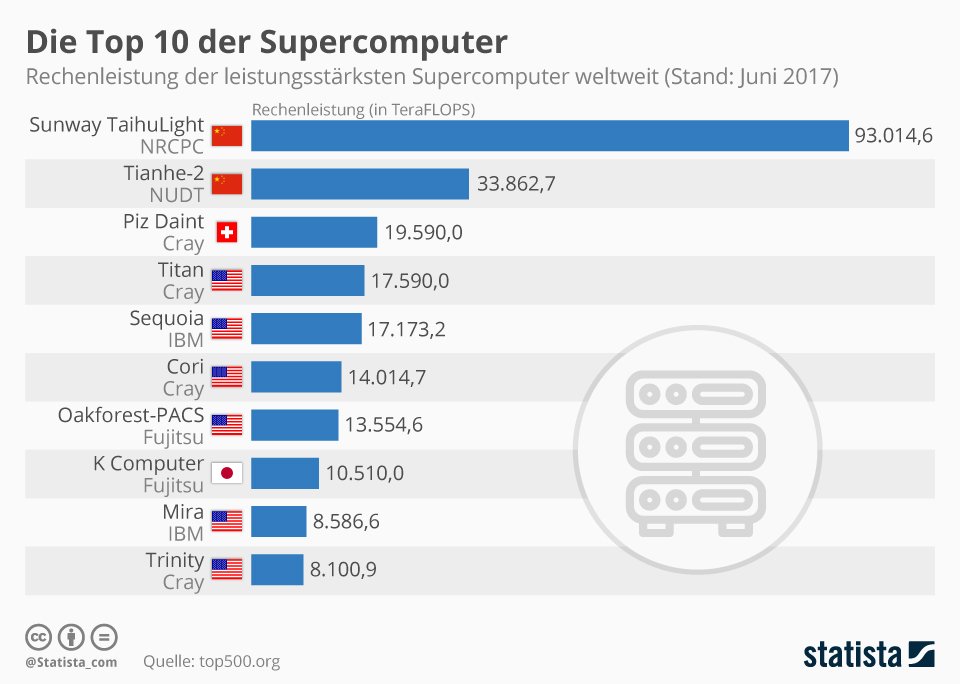Der K-Computer von Fujitsu hat zum zweiten Mal in Folge den ersten Platz des High Performance Conjugate Gradient (HPCG) Benchmark-Index erreicht. Durch stetiges Verbessern der System- und Anwendungsleistungen hat der Fujitsu K-Computer die Zweitplatzierungen aus den Jahren 2014 und 2015 übertroffen.
Für die Benchmark-Auszeichnung wurden alle 82.944 Berechnungsknoten des K-Computer verwendet, um eine Leistung von 602 Teraflops zu erreichen. Diese Zahl ist weit höher als die der Supercomputer, die in den TOP500-Rankings höher platziert wurden und beweist die hervorragende Leistung des K-Computers in verschiedenen Bereichen der Wissenschaft und Technik.
Fujitsu hat den Award auf der ISC High Performance 2017 in Frankfurt erhalten.
K computer takes first place for the second consecutive time on HPCG benchmark
On June 19, the K computer took first place for the second consecutive time in the HPCG benchmark, a new index developed to create a more realistic view of supercomputer performance compared to the commonly used LINPACK benchmark. This success, which surpasses the second place achieved in 2014 and 2015, was made possible by subsequent improvements of the performance of the system and applications.
The HPCG (High Performance Conjugate Gradient) benchmark measures how fast a computer can solve symmetric sparse linear system equations using the conjugate gradient method preconditioned with a multi-grid symmetric Gauss-Seidel smoother. Problems of this type are typically encountered in actual engineering and industrial applications, and require a balance between calculation performance, memory performance and communication performance, unlike LINPACK, which looks at calculation speed alone.
For this result, all of the K computer’s 82,944 compute nodes were used, achieving a performance of 602 teraflops. This figure is higher than the supercomputers that placed higher than the K computer in the TOP500 rankings, demonstrating outstanding performance in various science and engineering fields.
According to Mike Heroux of Sandia National Laboratories, who developed the HPCG benchmark, „The HPCG benchmark is very demanding. A good score requires strong and versatile memory system performance, excellent interconnect network performance at scale, and an overall balanced system. The top ranking of the K computer is no surprise.“
About RIKEN
RIKEN is Japan’s flagship research institute devoted to basic and applied research. Over 2500 papers by RIKEN researchers are published every year in reputable scientific and technical journals, covering topics ranging across a broad spectrum of disciplines including physics, chemistry, biology, medical science and engineering. RIKEN’s advanced research environment and strong emphasis on interdisciplinary collaboration has earned itself an unparalleled reputation for scientific excellence in Japan and around the world. For more information, please see: https://www.riken.jp/
Bildquelle: https://www.hpcg-benchmark.org/custom/index.html?lid=155&slid=291
Bildquelle: https://www.hpcg-benchmark.org/custom/index.html?lid=155&slid=289
Die Top 10 der Supercomputer
Hier folgt eine Auswahl an Fachbeiträgen, Studien, Stories und Statistiken die zu diesem Thema passen. Geben Sie in der »Artikelsuche…« rechts oben Ihre Suchbegriffe ein und lassen sich überraschen, welche weiteren Treffer Sie auf unserer Webseite finden.
Auf dem Weg zum modularen Superrechner der nächsten Generation
Die schnellsten Rechner der Welt: Jülicher Supercomputer weiterhin in den Top 10
Wir nehmen nur Bitcoins! – Fünf Bereiche, die Blockchain verändern wird



